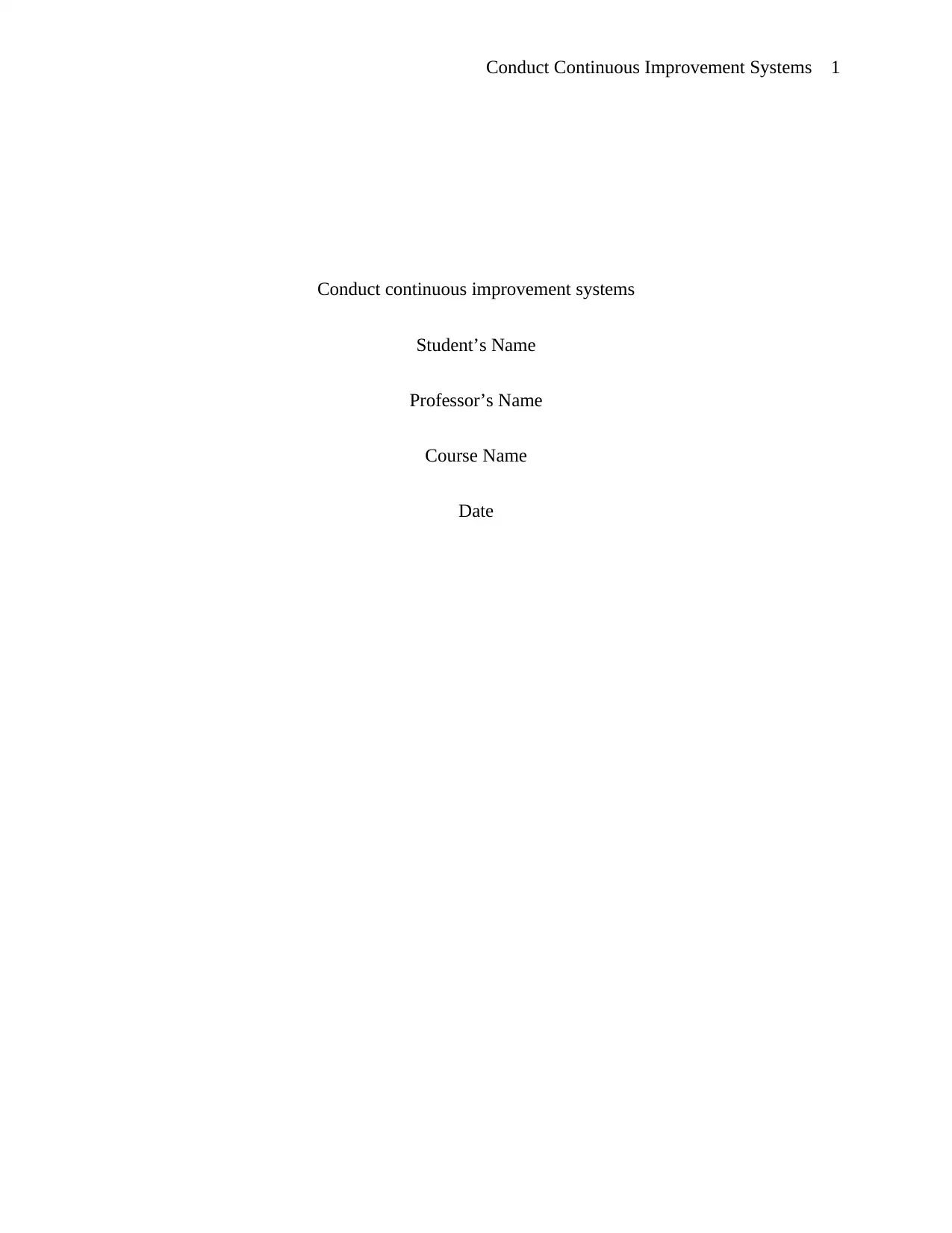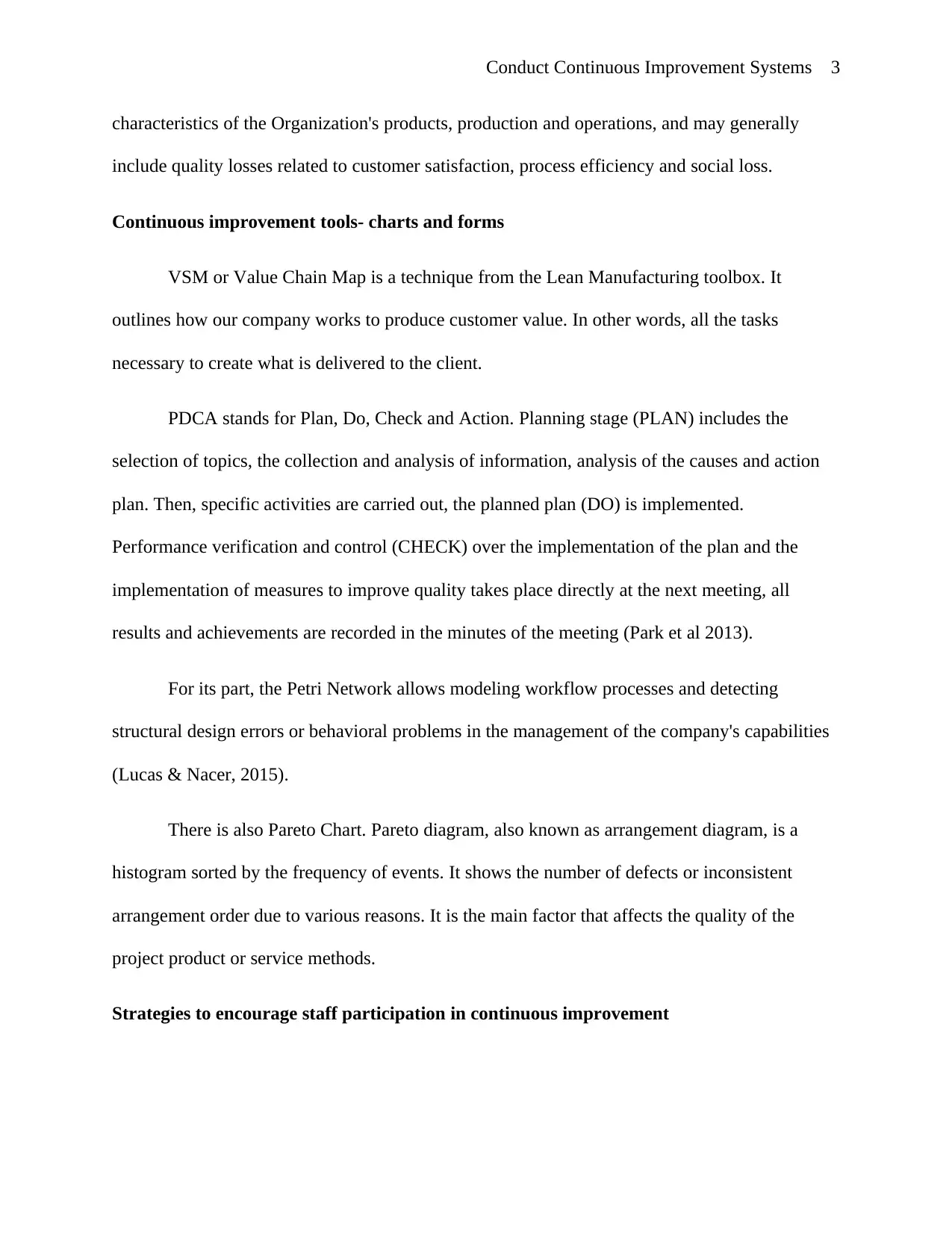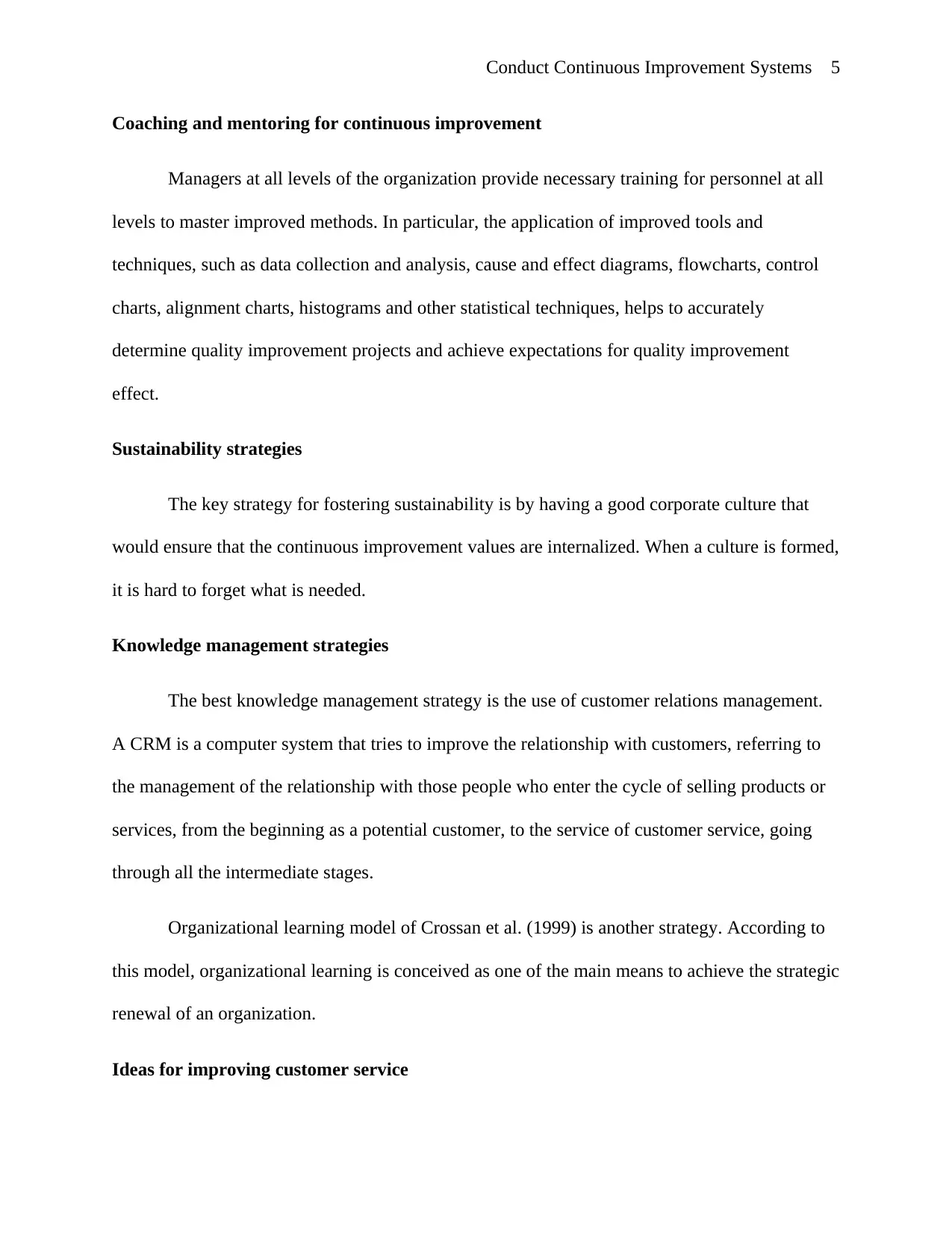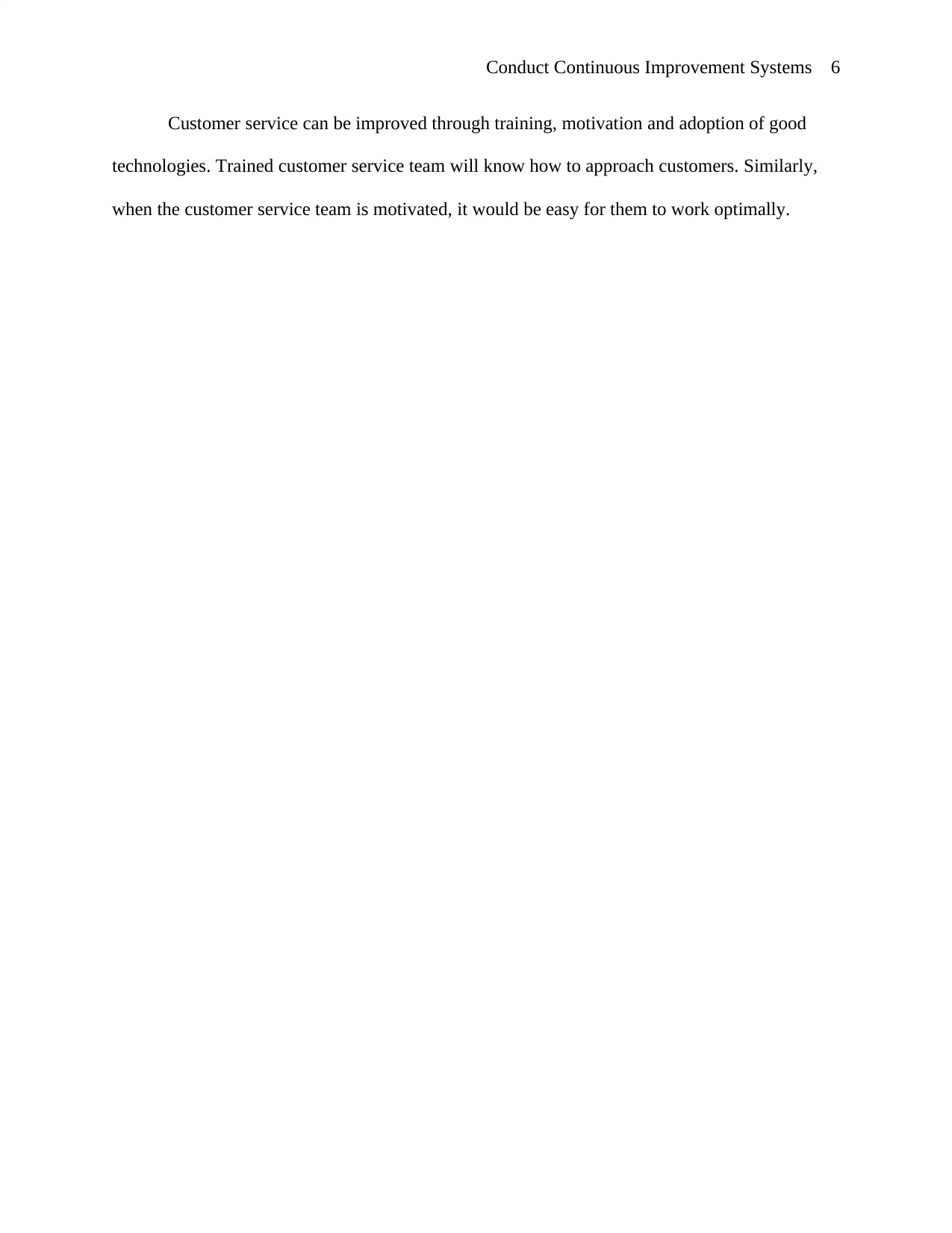Strategies for Continuous Improvement Systems: A Comprehensive Report
VerifiedAdded on 2022/08/14
|7
|1375
|12
Report
AI Summary
This report provides a comprehensive overview of continuous improvement systems, focusing on their benefits, models, and implementation strategies. It explores the importance of continuous improvement in enhancing organizational competitiveness and customer satisfaction. The report details two key models: Sigma and TQM (Total Quality Management), and ServQual. It also outlines various strategies for building continuous improvement, including performance management, sustainability, and knowledge management, along with tools such as VSM and PDCA cycle. Furthermore, the report discusses strategies to encourage staff participation, including appreciation, a sense of belonging, and recognition, along with communication and awareness strategies. Coaching, mentoring, and sustainability strategies are also addressed, emphasizing the role of corporate culture and customer relations management (CRM). The report concludes by highlighting ideas for improving customer service through training, motivation, and technology adoption. The document is a valuable resource for students seeking to understand and implement effective continuous improvement practices.

Conduct Continuous Improvement Systems 1
Conduct continuous improvement systems
Student’s Name
Professor’s Name
Course Name
Date
Conduct continuous improvement systems
Student’s Name
Professor’s Name
Course Name
Date
Paraphrase This Document
Need a fresh take? Get an instant paraphrase of this document with our AI Paraphraser

Conduct Continuous Improvement Systems 2
Benefits of implementing continuous improvement
Continuous improvement serves to ensure that the organization's competitiveness is
continuously enhanced to satisfy customers. This is the eternal goal of managers at all levels of
the organization and an eternal theme of the organization (Schmal and Olave, 2014).
Models (at least 2) for E-OfficeWorx- Sigma and TQM
Total Quality Management (TQM) integrates mainly three principles: staff participation,
continuous improvement and customer satisfaction. The other model is the ServQual model
represents one of the main results of the programmatic research initiated by Parasuraman et al.
(1994). In sum, the ServQual model offers a map of the situation regarding the quality in the
provision of the service and the aspects that the client truly values when accessing said service,
as is the case of the restaurant under study(Du and Tang, 2014).
Ways of building continuous improvement- performance management, sustainability, and
knowledge management
The continuous improvement of the E-OfficeWorx shall be combined with preventive
and corrective actions. According to the PDCA cycle, they plan, organize and implement,
strengthen inspections, and take steps in stages to recognize and promote the improved results,
and implement effective measures at new levels Control and then establish new improvement
goals.
The E-OfficeWorx shall establish a quality improvement measurement and evaluation
system in order to identify, diagnose and evaluate the effects of quality improvement
opportunities. Quality improvement measurement systems should be appropriate to the
Benefits of implementing continuous improvement
Continuous improvement serves to ensure that the organization's competitiveness is
continuously enhanced to satisfy customers. This is the eternal goal of managers at all levels of
the organization and an eternal theme of the organization (Schmal and Olave, 2014).
Models (at least 2) for E-OfficeWorx- Sigma and TQM
Total Quality Management (TQM) integrates mainly three principles: staff participation,
continuous improvement and customer satisfaction. The other model is the ServQual model
represents one of the main results of the programmatic research initiated by Parasuraman et al.
(1994). In sum, the ServQual model offers a map of the situation regarding the quality in the
provision of the service and the aspects that the client truly values when accessing said service,
as is the case of the restaurant under study(Du and Tang, 2014).
Ways of building continuous improvement- performance management, sustainability, and
knowledge management
The continuous improvement of the E-OfficeWorx shall be combined with preventive
and corrective actions. According to the PDCA cycle, they plan, organize and implement,
strengthen inspections, and take steps in stages to recognize and promote the improved results,
and implement effective measures at new levels Control and then establish new improvement
goals.
The E-OfficeWorx shall establish a quality improvement measurement and evaluation
system in order to identify, diagnose and evaluate the effects of quality improvement
opportunities. Quality improvement measurement systems should be appropriate to the

Conduct Continuous Improvement Systems 3
characteristics of the Organization's products, production and operations, and may generally
include quality losses related to customer satisfaction, process efficiency and social loss.
Continuous improvement tools- charts and forms
VSM or Value Chain Map is a technique from the Lean Manufacturing toolbox. It
outlines how our company works to produce customer value. In other words, all the tasks
necessary to create what is delivered to the client.
PDCA stands for Plan, Do, Check and Action. Planning stage (PLAN) includes the
selection of topics, the collection and analysis of information, analysis of the causes and action
plan. Then, specific activities are carried out, the planned plan (DO) is implemented.
Performance verification and control (CHECK) over the implementation of the plan and the
implementation of measures to improve quality takes place directly at the next meeting, all
results and achievements are recorded in the minutes of the meeting (Park et al 2013).
For its part, the Petri Network allows modeling workflow processes and detecting
structural design errors or behavioral problems in the management of the company's capabilities
(Lucas & Nacer, 2015).
There is also Pareto Chart. Pareto diagram, also known as arrangement diagram, is a
histogram sorted by the frequency of events. It shows the number of defects or inconsistent
arrangement order due to various reasons. It is the main factor that affects the quality of the
project product or service methods.
Strategies to encourage staff participation in continuous improvement
characteristics of the Organization's products, production and operations, and may generally
include quality losses related to customer satisfaction, process efficiency and social loss.
Continuous improvement tools- charts and forms
VSM or Value Chain Map is a technique from the Lean Manufacturing toolbox. It
outlines how our company works to produce customer value. In other words, all the tasks
necessary to create what is delivered to the client.
PDCA stands for Plan, Do, Check and Action. Planning stage (PLAN) includes the
selection of topics, the collection and analysis of information, analysis of the causes and action
plan. Then, specific activities are carried out, the planned plan (DO) is implemented.
Performance verification and control (CHECK) over the implementation of the plan and the
implementation of measures to improve quality takes place directly at the next meeting, all
results and achievements are recorded in the minutes of the meeting (Park et al 2013).
For its part, the Petri Network allows modeling workflow processes and detecting
structural design errors or behavioral problems in the management of the company's capabilities
(Lucas & Nacer, 2015).
There is also Pareto Chart. Pareto diagram, also known as arrangement diagram, is a
histogram sorted by the frequency of events. It shows the number of defects or inconsistent
arrangement order due to various reasons. It is the main factor that affects the quality of the
project product or service methods.
Strategies to encourage staff participation in continuous improvement
⊘ This is a preview!⊘
Do you want full access?
Subscribe today to unlock all pages.

Trusted by 1+ million students worldwide

Conduct Continuous Improvement Systems 4
A number of strategies can be used to encourage staff participation and continuous
improvement. One of the strategies is appreciation. It means making people important, offering
support, moving to their jobs to greet them and appreciate their work, treating them by name,
encouraging them in difficult times, thanking them for their efforts. The second strategy is sense
of Belonging. It entails making them work as a team will make them feel motivated and
committed. There is also aspect of participation. It is used to channel suggestions and improve
their own work, as well as to solve problems. Recognition is another method.
Process of communicating the continuous improvement processes
There is no single communication channel that would be preferred. E-OfficeWorx should
use variety of communication channels such as meetings, email, noticeboards and even the social
media tools.
Strategies for staff awareness
There are many strategies for fostering staff awareness. The most convenient thing is to
hold meetings with everyone, in groups of ten to fifteen people. The purpose of these meetings is
to connect each of these, with the scope and advantages that the company and its components
can bring in the application of a quality program of customer service, based on communication,
committing them to support it with a positive attitude.
Feedback strategies to use
E-OfficeWorx should borrow from Kaizen’s strategies. Kaizeners spends a lot of time
measuring customer satisfaction and error rates. They also often discuss results at meetings and
platforms and focus on possible improvements (Silva, et al 2014).
A number of strategies can be used to encourage staff participation and continuous
improvement. One of the strategies is appreciation. It means making people important, offering
support, moving to their jobs to greet them and appreciate their work, treating them by name,
encouraging them in difficult times, thanking them for their efforts. The second strategy is sense
of Belonging. It entails making them work as a team will make them feel motivated and
committed. There is also aspect of participation. It is used to channel suggestions and improve
their own work, as well as to solve problems. Recognition is another method.
Process of communicating the continuous improvement processes
There is no single communication channel that would be preferred. E-OfficeWorx should
use variety of communication channels such as meetings, email, noticeboards and even the social
media tools.
Strategies for staff awareness
There are many strategies for fostering staff awareness. The most convenient thing is to
hold meetings with everyone, in groups of ten to fifteen people. The purpose of these meetings is
to connect each of these, with the scope and advantages that the company and its components
can bring in the application of a quality program of customer service, based on communication,
committing them to support it with a positive attitude.
Feedback strategies to use
E-OfficeWorx should borrow from Kaizen’s strategies. Kaizeners spends a lot of time
measuring customer satisfaction and error rates. They also often discuss results at meetings and
platforms and focus on possible improvements (Silva, et al 2014).
Paraphrase This Document
Need a fresh take? Get an instant paraphrase of this document with our AI Paraphraser

Conduct Continuous Improvement Systems 5
Coaching and mentoring for continuous improvement
Managers at all levels of the organization provide necessary training for personnel at all
levels to master improved methods. In particular, the application of improved tools and
techniques, such as data collection and analysis, cause and effect diagrams, flowcharts, control
charts, alignment charts, histograms and other statistical techniques, helps to accurately
determine quality improvement projects and achieve expectations for quality improvement
effect.
Sustainability strategies
The key strategy for fostering sustainability is by having a good corporate culture that
would ensure that the continuous improvement values are internalized. When a culture is formed,
it is hard to forget what is needed.
Knowledge management strategies
The best knowledge management strategy is the use of customer relations management.
A CRM is a computer system that tries to improve the relationship with customers, referring to
the management of the relationship with those people who enter the cycle of selling products or
services, from the beginning as a potential customer, to the service of customer service, going
through all the intermediate stages.
Organizational learning model of Crossan et al. (1999) is another strategy. According to
this model, organizational learning is conceived as one of the main means to achieve the strategic
renewal of an organization.
Ideas for improving customer service
Coaching and mentoring for continuous improvement
Managers at all levels of the organization provide necessary training for personnel at all
levels to master improved methods. In particular, the application of improved tools and
techniques, such as data collection and analysis, cause and effect diagrams, flowcharts, control
charts, alignment charts, histograms and other statistical techniques, helps to accurately
determine quality improvement projects and achieve expectations for quality improvement
effect.
Sustainability strategies
The key strategy for fostering sustainability is by having a good corporate culture that
would ensure that the continuous improvement values are internalized. When a culture is formed,
it is hard to forget what is needed.
Knowledge management strategies
The best knowledge management strategy is the use of customer relations management.
A CRM is a computer system that tries to improve the relationship with customers, referring to
the management of the relationship with those people who enter the cycle of selling products or
services, from the beginning as a potential customer, to the service of customer service, going
through all the intermediate stages.
Organizational learning model of Crossan et al. (1999) is another strategy. According to
this model, organizational learning is conceived as one of the main means to achieve the strategic
renewal of an organization.
Ideas for improving customer service

Conduct Continuous Improvement Systems 6
Customer service can be improved through training, motivation and adoption of good
technologies. Trained customer service team will know how to approach customers. Similarly,
when the customer service team is motivated, it would be easy for them to work optimally.
Customer service can be improved through training, motivation and adoption of good
technologies. Trained customer service team will know how to approach customers. Similarly,
when the customer service team is motivated, it would be easy for them to work optimally.
⊘ This is a preview!⊘
Do you want full access?
Subscribe today to unlock all pages.

Trusted by 1+ million students worldwide

Conduct Continuous Improvement Systems 7
List of References
Crossan, M. Lane, H. and White, R. (1999). An Organizational Learning Framework: from
Intuition to Institution. Academy of Management Review, 24 (3), 522-537.
Du, Y. and Tang, Y. A. (2014). Literature Review on the Relationship Between Service Quality
and Customer Loyalty. Business and Management Research, 3 (3), 27-33
Lucas, B., and Nacer, H. (2015). The habits of an improver: Thinking about learning for
improvement in health care. London: Health Foundation. Available from:
http://www.health.org.uk/publication/habits-improver
Parasuraman, A., Zeithaml, VA and Berry, LL.A. (1994). Reassessment of Expectations as a
Comparison Standard in Measuring Service Quality: Implications for Further Research, Journal
of Marketing, 58, 111-124
Park, S., Hironaka, S., Carver, P. and Nordstrum, L. (2013). Continuous improvement in
education. Carnegie Foundation for the Advancement of Teaching. Available from
https://www.carnegiefoundation.org/resources/publications/continuous-improvementeducation/
Silva, V., Schramm, F., Costa, M. and Danielle, A. (2014). Proposal of a Procedure for
Evaluating Individual's Expectations and Perceptions Based on ServQual 2014 IEEE
International Conference on Systems, Man, and Cybernetics, San Diego, CA, USA October 5-8
List of References
Crossan, M. Lane, H. and White, R. (1999). An Organizational Learning Framework: from
Intuition to Institution. Academy of Management Review, 24 (3), 522-537.
Du, Y. and Tang, Y. A. (2014). Literature Review on the Relationship Between Service Quality
and Customer Loyalty. Business and Management Research, 3 (3), 27-33
Lucas, B., and Nacer, H. (2015). The habits of an improver: Thinking about learning for
improvement in health care. London: Health Foundation. Available from:
http://www.health.org.uk/publication/habits-improver
Parasuraman, A., Zeithaml, VA and Berry, LL.A. (1994). Reassessment of Expectations as a
Comparison Standard in Measuring Service Quality: Implications for Further Research, Journal
of Marketing, 58, 111-124
Park, S., Hironaka, S., Carver, P. and Nordstrum, L. (2013). Continuous improvement in
education. Carnegie Foundation for the Advancement of Teaching. Available from
https://www.carnegiefoundation.org/resources/publications/continuous-improvementeducation/
Silva, V., Schramm, F., Costa, M. and Danielle, A. (2014). Proposal of a Procedure for
Evaluating Individual's Expectations and Perceptions Based on ServQual 2014 IEEE
International Conference on Systems, Man, and Cybernetics, San Diego, CA, USA October 5-8
1 out of 7
Related Documents
Your All-in-One AI-Powered Toolkit for Academic Success.
+13062052269
info@desklib.com
Available 24*7 on WhatsApp / Email
![[object Object]](/_next/static/media/star-bottom.7253800d.svg)
Unlock your academic potential
Copyright © 2020–2025 A2Z Services. All Rights Reserved. Developed and managed by ZUCOL.




